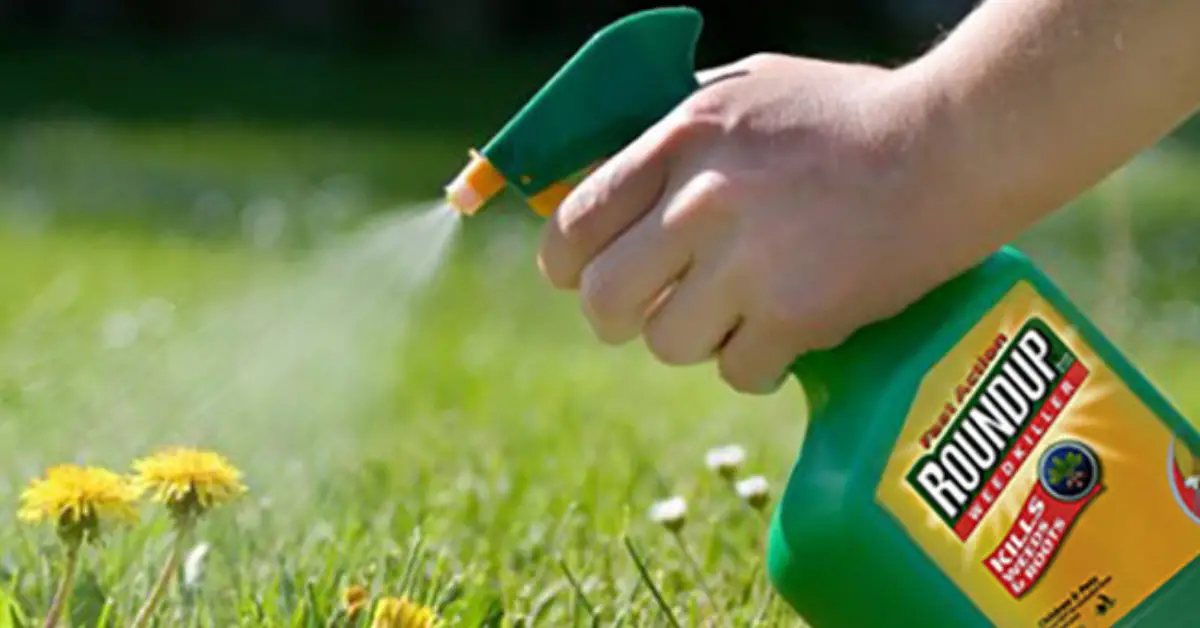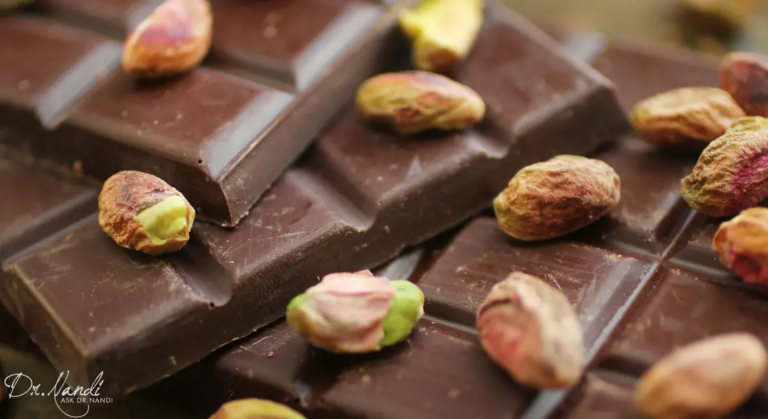One of the most common questions I hear in regards to organic gardening is this: what do I use to kill weeds and pests?
It’s true, unwelcome weeds and bugs are the bane of every gardener. Keeping them under control may be the most time-consuming part of growing your own food. It’s why such potent, toxic chemicals like Roundup were invented in the first place. Common pesticide and herbicide brands come with the promise of making your life easier by easily killing off unwanted plants and pests, but at what cost?
Why Not Use Roundup?
Roundup is the most popular brand of weed killer in the world. It was invented by biotech giant Monsanto in 1974 and is still mass-produced by them today. It is used by farmers, home-gardeners, lawn specialists and just about everyone who is growing food or plants in one capacity or another.
Some studies have claimed Roundup to be safe an environmentally friendly, but the majority of these studies are done on Glyphosate alone and not the entire Roundup mixture.
Roundup is made of Glyphosate; an organophosphorus compound, broad-spectrum systemic herbicide. It is designed to kill unwanted plants and is toxic at some dose to all living things. Although glyphosate is certianly problematic (especially to the human microbiome), other ingredients in roundup may be even more toxic. Such ingredients are often hidden by manufacturers and labeled only as “formulations” or “inerts”. These ingredients have been found to be quite poisonous and unsafe for consumption, even in tiny amounts. Let’s take a look at some of the research. (3)
- Glyphosate Formulations Cause Total Cell Death. Eye-opening research by the University of Caen in France discovered that Roundup causes total cell death to umbilical, embryonic and placental human cells within 24 hours of exposure. Scientists used Roundup diluted to a 10/1 ratio (expected amount to end up as residue on food or animal feed). This amount is 300-600 times lower than normal agricultural dilutions. Among several brands of herbicides tested during this study, Roundup was by far the most toxic. (1,2)
- Other Ingredients In Roundup Are Significantly More Toxic To Human Cells Than Glyphosate Alone. Several studies have found that the undeclared ingredients in pesticides are more toxic to human cells than their declared active principals. (4, 5, 6, 7)
- The World Health Organization (WHO) Declared Glyphosate As A Carcinogen. WHO has listed glyphosate as “probably carcinogenic to humans”. This means it has the potential to cause cancer based on observational studies, animal studies and test tube studies. (8)
- Studies Have Linked Glyphosate To Non-Hodgkin Lymphoma. Several studies have found an increased risk for this cancer in male farm workers who are often exposed to glyphosate due to using it on their farms. (9, 10, 11)
- Reviews Finding No Association Between Glyphosate and Cancer May Have Conflict Of Interest. There have been a some recent reviews that found no association between glyphosate and cancer, but the authors of these reviews have financial ties to Monsanto, which points to clear conflict of interest. (12, 13)
- Roundup Negatively Affects Gut Bacteria. Roundup works primarily by blocking a metabolic pathway called the “shikimate pathway” that is used by both plants and beneficial bacteria in the human microbiome. Another interesting find: glyphosate disrupts beneficial bacteria, while harmful bacteria is highly resistant. (14, 15, 16)
- Glyphosate Products May Be Linked To Fertility Issues. One study of farm workers found glyphosate products may be linked to pregnancy issues. (17) Other animal-based studies have found a high incidence of birth defects in regions where glyphosate products are heavily used. (18)
- Glyphosate-Based Herbicides May Interfere With Normal Sexual Development. Studies have found these cause morphological damage to ovaries. (21)
- Glyphosate-Based Herbicides Cause Endocrine Disruption. Children, infants and developing fetus are most at risk. Although exposure may not cause immediate symptoms, early-life exposure is linked to adverse conditions that appear later in life. (19,20)
- Glyphosate-Based Herbicides Create Antibiotic-Resistant Bacteria Strains. Studies have found that glyphosate-based products alter the susceptibility of harmful bacteria to 6 different types of antibiotics, meaning they bacteria become resistant to these antibiotics at normal doses. This may create resistant bacteria phenotypes that make their way into the human population. (22)
This is not a comprehensive list of studies, but rather a short list of some of the most dangerous side-effects of Roundup that everyone should be aware of. A product with such questionable safety, in my mind, should never be allowed near anything intended for human consumption. Even if you wash your fruits and vegetables before you eat them, herbicide residue is nearly impossible to remove completely.

What Non-Toxic Methods Can I Use For Weeds & Pests In My Garden?
What should you use in your organic garden to keep pesky weeds and bugs at bay? There are plenty of safe, non-toxic options that are effective at eliminating weeds and bugs or preventing them from entering your garden in the first place. Here are some of the best:
10 Organic Weed Control Methods
#1 Mulching
Cover your garden soil with generous amounts of mulch at the start of every season. This will help to smother and inhibit the growth of weeds. Some good types of mulch include:
- Wheat straw
- Pine needles
- Compost
- Pine bark
- Grass clippings
- Wood chips
You can use two or three different types of mulch, burying lighter ones like newspaper and straw under wood chips, compost, etc. Along with mulching at the beginning of the season, you can also add mulch throughout as needed.
#2 Crowding
Crowding is essentially planting lots of things close together (strategically) so that there is no room left for weeds. There are a few different methods for doing this, including Square-Foot gardening or wide-row planting. You plant things together close enough so that when they are full grows, they leaves touch, keeping the sunlight from any weeds growing below. This is also a great method if you don’t have a lot of square footage to work with and are gardening in a small space.
#3 No-Till Method
Tilling brings new weeds and seeds to the surface and is not necessary for successful planting. Leaving the soil undisturbed except for individual spots for seeds is better for fertility and soil structure, and also supports beneficial organisms. Try the no-till method or Lasagne gardening method, explained in the video below.
#4 Solarizing
This is a fairly simple but effective method for preventing weed growth. It entails covering a weedy area of soil with a clear, heavy plastic sheet. The sun will heat up the plastic sheet and cook the weeds underneath. Leave it in place until all the weeds are dry and brown. Then you can remove the sheet and clear out all the weeds and add mulch to prevent further growth.
#5 Drip Irrigation
If you don’t want weeds to grow, don’t water them! A lot of beginner gardeners water every bit of the garden with a hose or sprinkler system. This provides water to areas of soil where you aren’t intending to grow anything and thus providing weeds with opportunity to sprout. To avoid this, use an effective drop irrigation system that delivers water only to your seedlings and plants.
#6 Boiling Water
A quick way to kill any weeds that are growing in your pavement or garden paths is to boil a kettle of water, and pour it directly on the weeds you want to kill. You should be able to easily pull them up after this. The water will cool quickly and not damage nearby plants that you want to keep around.
#7 Vodka
Here is a simple DIY weed killer recipe. You can spray this on weeds growing in full sun to kill them. This will dry out any plant you spray it on so avoid getting it on your wanted plants.
Ingredients
- Spray bottle
- 4 ounces vodka (rubbing alcohol also works)
- 4-8 drops dish soap
Instructions
- Combine all ingredients into the spray bottle and shake to combine. Spray directly on weeds that are growing in full sun.
#8 Vinegar & Salt
This is another weed killer recipe that uses vinegar instead of alcohol. It will be most effective if you find a solution that is 20%-30% vinegar, although you will want to wear gloves and glasses when using it so it doesn’t get on your skin or in your eyes. It WILL burn!
Ingredients
- 1 gallon white vinegar (5%-30% vinegar. The higher, the more powerful)
- 1 cup table sale
- 1 tbsp dish soap
Instructions
- Combine all ingredients into the spray bottle and shake to combine. Spray directly on weeds that. Most effective on weeds growing in the sun.
#9 Corn Gluten
Corn gluten is a byproduct of the corn milling process. If you apply it to un-sprouted weeds it will prevent them from germinating. You ONLY want to use this AFTER your wanted seeds have sprouted, otherwise it will keep them from sprouting. This is non-toxic and very effective at preventing weeds from sprouting. It will not, unfortunately, work on any weeds that are already growing. I recommend finding organic corn gluten meal as this will be free of GMO or glyphosate residue.
#10 Flame Weeders
Here’s a fun weeding tool! A flame weeder is a long wand connected to a propane tank. It lights weeds on fire. Be extremely careful using this during a dry season because you could catch your whole garden on fire if a little wind blows your flame around. This will effectively kill the above-ground portion of any weeds.
10 Organic Pest Control Methods
#1 Diatomaceous Earth
Diatomaceous earth comes from sedimentary rock and looks like a fine white, chalky powder. It is an effective natural bug repellent and bug killer. You can sprinkle it around plants to protect them or mix it with some water and spray it directly on the leaves. It will not harm you plants, but can be deadly to beneficial insects so use only as necessary (don’t dump it over your entire garden).
Purchase food-grade diatomaceous earth and not the kind they sell at pool supply stores.
#2 Beneficial Bugs
There are many bugs that will benefit your garden by eating the bugs that want to eat your plants. Some examples of these include lady bugs, some spiders, lacewings, tachinid flies, praying mantis and even wasps. To attract beneficial bugs you can plant certain flowers that they like. For example:
- Lady bugs are attracted to cosmos, geraniums and dandelions.
- Herbs like dill, fennel, caraway and cilantro will attract praying mantis.
- Lacewings like dill, caraway, fennel, dandelions and sunflowers.
- Wasps enjoy lavender lily, dill, caraway, coriander, fennel, tansy and lemon balm.
- Tachinid flies like parsley, buckwheat, lemon balm and thyme.
#3 Companion Planting
Instead of planting everything separately, use this guide to plant certain things together to help repel bugs and build a healthy thriving ecosystem in your garden. Pests are picky. If you plant something they don’t like next to something they do, chances are they won’t touch it.
#4 Silver Reflective Mulch
This is a fairly new method for organic pest control but has proven effective for many gardeners. Silver reflective mulch is a thin silver sheet laid down on soil near plants. It scares away birds and insects and also shines light on the underside of leaves where many pests love to hide.
#5 Neem oil
A very popular non-toxic pest control method, neem oil is used around the world to repel ants, aphids, beetles, caterpillars, cockroaches, houseflies, snails, termites and many other types of bugs. It is made from neem tree seeds and is very safe.
#6 Garlic Oil Spray
Pests don’t like garlic! You can make a garlic oil spray by mixing 4 parts waters to one part garlic oil. Spray it directly on the leaves and stems of your plants to keep unwanted bugs away. This will not hurt your plants. If you don’t want to make garlic oil spray you can also plant garlic in bunches around your garden to discourage bugs.
#7 CedarCide
This is one brand-name product I recommend because it i made from cedar oil and contains no toxic ingredients or chemicals. Cedar oil is a natural bug repellent but is safe for humans, plants and animals. You can use it directly on your garden to discourage pests.
#8 Rotate The Crops
Don’t plant everything in the same place every year or pests will know exactly where to find everything! Use a rotating crop system and this will not only help with pest control but will also support good soil health.
#9 Keep Your Plants Healthy
Pests are more attracted to sick plants than healthy ones. If you keep your plants thriving, it will help to keep your pest problem minimal. If you do have a sick plant that is not going to make it, better to pull it out immediately then let it sit.
#10 Copper & Salt
Copper and salt are effective slug repellents. You can use strips of copper around plants and spread salt on the soil near them. Copper will shock slugs that come near it. Salt will dry them out. Too much salt can be harmful to plants so don’t use it excessively.
Conclusion
Organic gardening is all about viewing the garden as an ecosystem and not just individual plants, weeds and pests. There are so many options to keeping your garden healthy and free of weeds and pests, there is simply no reason to ever use a toxic product.
Do you have any questions? Feel free to comment below.
References
- https://pubs.acs.org/doi/abs/10.1021/tx800218n
- https://www.hindawi.com/journals/bmri/2014/179691/?hc_location=ufi
- https://www.ncbi.nlm.nih.gov/pubmed/17185266
- https://www.ncbi.nlm.nih.gov/pubmed/24719846/
- https://www.ncbi.nlm.nih.gov/pubmed/23000283/
- https://www.ncbi.nlm.nih.gov/pubmed/9167243/
- https://www.ncbi.nlm.nih.gov/pubmed/9888965
- https://www.ncbi.nlm.nih.gov/pubmed/25801782
- https://www.ncbi.nlm.nih.gov/pubmed/12937207
- https://www.ncbi.nlm.nih.gov/pubmed/11700263
- https://www.ncbi.nlm.nih.gov/pubmed/18623080
- https://www.ncbi.nlm.nih.gov/pubmed/22683395
- https://www.ncbi.nlm.nih.gov/pubmed/25716480
- https://www.ncbi.nlm.nih.gov/pubmed/15012217
- https://www.ncbi.nlm.nih.gov/pubmed/23224412
- https://www.ncbi.nlm.nih.gov/pubmed/23396248
- https://www.ncbi.nlm.nih.gov/pubmed/9420527/
- https://www.ncbi.nlm.nih.gov/pmc/articles/PMC4895883/
- https://www.ncbi.nlm.nih.gov/pmc/articles/PMC4756530/#CR21
- https://www.ncbi.nlm.nih.gov/pmc/articles/PMC4756530/#CR24
- https://www.ncbi.nlm.nih.gov/pmc/articles/PMC4756530/#CR74
- https://www.ncbi.nlm.nih.gov/pmc/articles/PMC4756530/#CR75











 Subscribe to Ask Dr. Nandi YouTube Channel
Subscribe to Ask Dr. Nandi YouTube Channel










